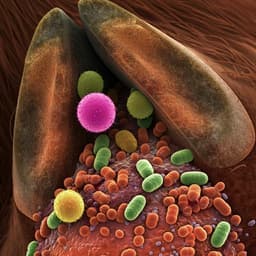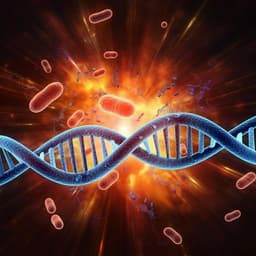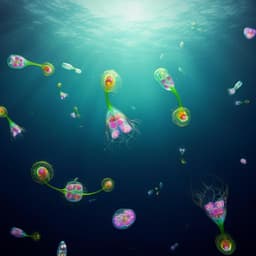
Food Science and Technology
Dominance of phage particles carrying antibiotic resistance genes in the viromes of retail food sources
P. Blanco-picazo, S. Morales-cortes, et al.
Explore the exciting findings of a study that uncovers the significant roles of phages, outer membrane vesicles, and contaminating DNA in antibiotic resistance genes within food viromes. Conducted by a team of researchers including Pedro Blanco-Picazo and Sara Morales-Cortes, this research reveals the intricate dynamics of viromes in our food systems.
~3 min • Beginner • English
Introduction
The study addresses how antibiotic resistance genes (ARGs) are mobilized within microbial communities, focusing on the contribution of bacteriophages (phages) relative to other mechanisms such as conjugation and transformation. While conjugation is widely accepted as a dominant ARG transfer route, growing evidence indicates phages frequently carry ARGs, suggesting their role in horizontal gene transfer is underestimated. However, reports of ARGs in viral fractions have been questioned due to potential contamination by non-packaged bacterial DNA and outer membrane vesicles (OMVs). The research question is whether ARGs detected in viromes from retail food sources are predominantly carried within bona fide phage particles, as opposed to OMVs or contaminating DNA. The purpose is to rigorously purify viral fractions, confirm ARG encapsidation, assess infectivity and particle identity, and quantify the relative contribution of phage particles versus OMVs, thereby validating protocols and clarifying the role of phages in ARG mobilization—an issue of high public health importance given escalating antimicrobial resistance.
Literature Review
The paper situates ARG transfer within known mechanisms of horizontal gene transfer: transformation, transduction, and conjugation, noting that conjugation has strong experimental support and is presumed most frequent in dense microbiomes. Transduction, though established historically, has been considered less impactful; yet numerous studies report frequent detection of ARGs in phage DNA fractions across environmental, food, and human samples. Skepticism has arisen that such detections may be inflated by contamination with non-packaged DNA or OMVs. The authors cite limited complete phage genomes carrying ARGs and scarcity of direct experimental transduction evidence, possibly because generalized or lateral transduction yields particles packaging large bacterial DNA fragments that are hard to propagate and cannot be identified as phage genomes by sequencing. They note that even 16S rRNA genes can be packaged within phage particles, countering the assumption that 16S detection always indicates contamination. The study builds on prior protocols designed to minimize false positives and on previous findings of ARG-containing phage particles in similar food matrices.
Methodology
Sample sources and processing: Two minced chicken meat samples (Chicken 1, Chicken 2), a pool of two mussel samples (Mussels), and a pool of three Mediterranean whiting samples (Fish) were purchased fresh from Barcelona supermarkets (2020–2022) and processed within 24 h. Twenty grams of each were homogenized in 60 ml phage buffer (100 mM NaCl, 10 mM MgCl2, 50 mM Tris-HCl, 0.01% gelatin, pH 7.5) using a Stomacher; filtered bags aided separation.
Microbiological indicators: Total aerobes (with/without 100 µg/ml ampicillin) were enumerated on TSA; E. coli (with/without 100 µg/ml ampicillin) on Chromocult Coliform Agar with a 2 h 37 °C preincubation then overnight at 44 °C. Ten percent of blue colonies were indole-tested and grown on MacConkey; triplicates per supernatant.
Viral fraction preparation: Fifty ml homogenate was filtered through 0.22 µm PES, treated with chloroform (10% v/v, 5 min), centrifuged (4000×g, 10 min) to separate phases; aqueous phase was treated with DNase I (100 U, 37 °C, 1 h) then heat-inactivated (75 °C, 5 min).
Propagation on host: DNase-treated filtrates (1 ml) were mixed with 1 ml mid-log E. coli WG5 (OD600 0.3) in 8 ml LB; incubated overnight at 37 °C with shaking. Post-incubation, suspensions were filtered (0.22 µm), chloroform-treated, and DNase-treated as above.
CsCl density gradient purification: Post-propagation suspensions were layered onto gradients (1 ml 20% sucrose; CsCl densities 1.3, 1.5, 1.7 g/ml) in Ultra-Clear tubes; ultracentrifuged (22,000×g, 2 h, 4 °C, SW-41 rotor). Visible gray bands (phage fraction) at ~1.3–1.5 g/ml were collected (0.5 ml), dialyzed (MWCO 12–14 kDa; Tris 0.1 M, EDTA 0.2 mM, pH 8; 1 h then fresh buffer 18 h with stirring). CsCl-purified suspensions were used for ARG qPCR, additional propagations, plaque assays, EM, infectivity imaging, and proteomics.
ARG detection and controls: For encapsidated DNA, DNase-treated samples were first tested by qPCR to confirm absence of target ARGs and 16S rRNA gene (i.e., no non-encapsidated DNA). Capsids were then lysed with proteinase K (20 mg/ml; 1 h, 55 °C) and DNA extracted by phenol-chloroform and chloroform with Phase Lock Gel tubes; ethanol-precipitated; resuspended in 50 µl water; quantified by Qubit. qPCR with TaqMan probes (StepOne) targeted blaTEM, sul1, tetW using gBlocks standards; triplicate reactions; standard curves for quantification; negative controls included. Controls confirmed absence of ARGs in host E. coli WG5 and verified DNase activity (including plasmid DNA digestion). After first propagation, two additional propagation rounds were conducted, with ARG quantification after each.
Plaque blot: Supernatant from propagation 1 was filtered/chloroform-treated; 10-fold dilutions plated using ISO 10705-2 with E. coli WG5; incubated 37 °C, 18 h. DIG-labeled blaTEM PCR product was used as probe for plaque hybridization on nylon membranes under stringent conditions (Roche DIG kit).
SYBR Gold staining and fluorescence microscopy: CsCl-purified phage suspensions were stained with SYBR Gold (20 µl 10X per ml; 1 h dark), washed four times with 0.01 M MgSO4 using 50 K MWCO centrifugal filters, final volume 1 ml. E. coli WG5 (mid-log, OD600 0.2) was DAPI-stained (20 µg/ml, 15 min), washed, resuspended in 0.01 M MgSO4, mixed with SYBR-stained particles (1:1), incubated 37 °C 1 h, fixed with 4% paraformaldehyde (5 min), washed, final 50 µl; imaged on Zeiss LSM 880 confocal microscope.
Electron microscopy: Seven µl CsCl-concentrated suspensions were applied to carbon/Formvar grids, negatively stained with 2% ammonium molybdate (pH 6.8, 2 min), imaged on JEOL 1010 TEM at 80 kV.
Proteomics: One hundred µl CsCl-concentrated suspensions were quantified (BCA), cleaned via SDS-PAGE, fixed (10% acetic acid/40% EtOH/50% water), washed. In-gel digestion: reduction (20 mM DTT, 60 °C, 60 min), alkylation (55 mM iodoacetamide, 25 °C, 30 min, dark), trypsin digestion (2 h then overnight, 37 °C). Peptides extracted (5% FA/50% ACN; 100% ACN), dried, stored −20 °C. LC-MSMS on nanoAcquity coupled to LTQ-Orbitrap Velos; top-15 DDA with CID (38% NCE). Data analyzed with Sequest HT in Proteome Discoverer v1.4.1.14 against a custom database (SwissProt full + TrEMBL viral entries), Percolator FDR control; proteins with ≥2 peptides and FDR ≤5% retained; protein size-normalized reporting.
Data analysis and reporting: ARG qPCR reported as log10 gene copies/ml; presence/absence relative to LOQ noted; plaque counts enumerated; EM morphology described; proteomic fractions categorized into phage, membrane (OMV-associated), and other host proteins; phage protein classes (tail, capsid, structural, uncharacterized) summarized.
Key Findings
- Direct detection of ARGs in viromes: In direct (pre-propagation) CsCl-purified samples, chicken had undetectable blaTEM, sul1, tetW; mussels and fish showed detectable amplification of some ARGs but below LOQ, indicating presence at low levels.
- Post-propagation increase: After one propagation round on E. coli WG5, blaTEM and sul1 were detected in mussels and chicken; blaTEM and tetW in fish. ARG copy numbers increased by approximately 3–5 log10 gene copies/ml compared to direct samples, indicating that a subset of ARG-carrying particles were infectious and amplified.
- Density and purity of particles: CsCl bands recovered at 1.3–1.5 g/ml buoyant density consistent with Caudovirales; DNase controls showed no ARG or 16S rRNA amplification prior to capsid lysis, excluding non-encapsidated DNA contamination.
- Plaque assays: Propagation 1 supernatants yielded plaques on E. coli WG5 at 10^6 PFU/ml (fish) to 10^8 PFU/ml (mussels and chicken). However, plaque blot hybridization with blaTEM probe was negative across samples, suggesting blaTEM-carrying particles did not form lytic plaques or were rare relative to other virulent phages.
- Subsequent propagations: Additional rounds (2 and 3) did not increase ARG copy numbers; slight decreases matched dilution factors (1/10 in round 2; 1/100 in round 3). This indicates most ARG-containing particles from round 1 did not further propagate in WG5, consistent with transducing/defective particles or loss of helper phages.
- Infectivity imaging: Confocal microscopy with SYBR Gold-stained particles and DAPI-stained E. coli showed phage-sized particles attached to cells in all samples; some cells exhibited green fluorescence consistent with DNA injection.
- Electron microscopy: Predominant morphotypes observed were siphoviruses (fish, mussels) and myoviruses (both chicken samples); tailless icosahedral capsids (50–55 nm) also noted. No structures compatible with OMVs were observed.
- Proteomics evidencing phage dominance and low OMV content: Fraction of unique peptides (size-normalized) assigned to phage proteins: 71.8% (fish), 52.9% (mussels), 78.7% (chicken 1), 64.1% (chicken 2). Membrane proteins (indicative of OMVs) were only 16.2% (fish), 21.4% (mussels), 4.2% (chicken 1), 3.8% (chicken 2). Viral proteins were mainly tail, capsid, and structural; many were uncharacterized but likely capsid-related. Host non-membrane proteins comprised the remainder.
- ARG distribution by sample: tetW detected only in fish; sul1 detected in mussels and both chicken samples; blaTEM detected broadly and at higher levels than other targets.
Overall, data demonstrate that the purified viromes from retail foods are dominated by bona fide phage particles carrying ARGs, with minimal contribution from OMVs or non-packaged DNA.
Discussion
The findings directly address the central question of whether ARGs detected in viromes from retail food sources are truly encapsidated within phage particles. Rigorous removal of non-encapsidated DNA (DNase treatment and negative pre-lysis qPCR for ARGs and 16S) and CsCl purification at canonical phage densities, combined with microscopy and proteomics, establish that the recovered particles are predominantly phages. The low abundance of membrane proteins indicates OMVs contributed little to the DNA recovered, and TEM failed to reveal OMV-like structures. The 3–5 log10 increases in ARG copy numbers after a single propagation round confirm that at least a subset of ARG-carrying particles are infectious in E. coli WG5, supporting phage-mediated mobilization potential. The absence of blaTEM-positive plaques and lack of increased ARG copies in subsequent propagations suggest that many ARG-bearing particles are transducing or defective particles containing bacterial DNA (from generalized or lateral transduction) rather than complete temperate phages harboring ARGs via specialized transduction. Alternative explanations such as phage-like plasmids or helper phage co-infection could also produce ARG-carrying virions detectable after one propagation but not sustained thereafter. Collectively, the results validate the methodological approach for studying ARGs in viromes and reinforce the concept that phage particles—rather than OMVs or free DNA—are major carriers of ARGs in retail food viromes. This has significant implications for understanding ARG dissemination pathways and the potential for transduction in food-associated microbiomes.
Conclusion
This study demonstrates that viromes purified from retail chicken, fish, and mussels are dominated by genuine phage particles that carry antibiotic resistance genes, with minimal interference from outer membrane vesicles or non-packaged DNA. Multiple orthogonal lines of evidence—infectivity assays, CsCl density purification, strict DNase controls, confocal microscopy, TEM morphotyping, and proteomics—converge to support the dominance of phage particles and the encapsidation of ARGs. While an initial propagation step amplified ARG copy numbers, the inability to detect ARG-positive plaques or to further increase ARG abundance across subsequent propagations indicates that transducing or defective particles likely account for much of the ARG carriage. The validated protocol provides confidence in prior and future virome-based assessments of ARG carriage by phages. Future work should (i) resolve the nature of ARG-bearing particles (lateral/generalized versus specialized transduction; involvement of phage-like plasmids), (ii) explore additional bacterial hosts to assess host range and transduction efficiency, (iii) apply long-read and targeted sequencing to characterize packaged DNA, and (iv) quantify environmental factors and co-infection dynamics that modulate generation and transfer of ARG-containing particles.
Limitations
- No successful experimental transduction of ARGs was achieved despite evidence of infective particles, limiting direct demonstration of functional gene transfer.
- Reliance on a single host strain (E. coli WG5) may underestimate propagation/transduction potential for other hosts.
- ARG-positive plaques were not detected; thus, the precise nature of ARG-bearing particles (transducing particles vs complete phages vs phage-like plasmids) remains unresolved.
- Direct ARG levels in chicken were below detection prior to enrichment, indicating sensitivity limits and potential underestimation of low-abundance particles.
- Subsequent propagation rounds did not increase ARG copy numbers, possibly due to competition with other lytic phages, loss of helper phages, or predominance of defective/transducing particles.
- Sequencing of packaged DNA was not performed, preventing definitive genomic characterization of ARG-bearing particles.
Related Publications
Explore these studies to deepen your understanding of the subject.







